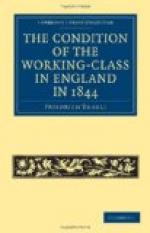Bradford contained in 1801 29,000, and in 1831 77,000
inhabitants.
Halifax ,, ,, 68,000, ,, ,, 110,000 ,,
Huddersfield ,, ,, 15,000, ,, ,, 34,000 ,,
Leeds,, ,, 53,000, ,, ,, 123,000 ,,
And the whole West Riding 564,000, ,, ,, 980,000 ,,
A population which, since 1831, must have increased at least 20 to 25 per cent. further. In 1835 the spinning of wool employed in the United Kingdom 1,313 mills, with 71,300 workers, these last being but a small portion of the multitude who are supported directly or indirectly by the manufacture of wool, and excluding nearly all weavers.
Progress in the linen trade developed later, because the nature of the raw material made the application of spinning machinery very difficult. Attempts had been made in the last years of the last century in Scotland, but the Frenchman, Girard, who introduced flax spinning in 1810, was the first who succeeded practically, and even Girard’s machines first attained on British soil the importance they deserved by means of improvements which they underwent in England, and of their universal application in Leeds, Dundee, and Belfast. From this time the British linen trade rapidly extended. In 1814, 3,000 tons of flax were imported; in 1833, nearly 19,000 tons of flax and 3,400 tons of hemp. The export of Irish linen to Great Britain rose from 32,000,000 yards in 1800 to 53,000,000 in 1825, of which a large part was re-exported. The export of English and Scotch woven linen goods rose from 24,000,000 yards in 1820 to 51,000,000 yards in 1833. The number of flax spinning establishments in 1835 was 347, employing 33,000 workers, of which one-half were in the South of Scotland, more than 60 in the West Riding of Yorkshire, Leeds, and its environs, 25 in Belfast, Ireland, and the rest in Dorset and Lancashire. Weaving is carried on in the South of Scotland, here and there in England, but principally in Ireland.




